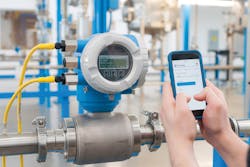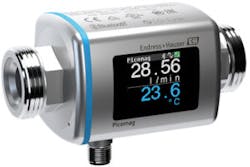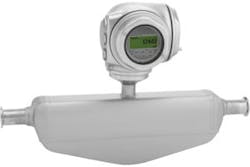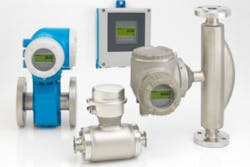Advancements in flowmeter technology
Throughout 2018, several trends in flowmeter technology were simply expansions, updates and refinements to existing technology, but two trends are turning the flowmeter industry on its ear: advances in flowmeter diagnostics and the adoption of smartphone-like technology to improve access, communications and, in the not-too-distant future, the displays attached to flowmeters.
This article reviews trends involving tiny flowmeters, specialty flowmeters, advanced diagnostics, improved communications between flowmeters and the enterprise, and the looming trend toward embodying smartphone technology into flowmeters.
Tiny flowmeters packed with capabilities
Some flowmeters have been getting smaller over the years. Dozens, if not hundreds, of compact, small and relatively inexpensive flowmeters are on the market. Electromagnetic flowmeters (magmeters) probably lead the trend toward miniaturization, mainly because the size of the flow element only needs to be barely bigger than the pipe or tube carrying the conductive liquid.
Tiny magmeters (as shown in Figure 1) are available for pipe sizes as small as 0.5 inches. Such tiny flowmeters are ideal for use on process skids, where space is often limited, or in difficult-to-reach locations. Although tiny, these flowmeters pack extensive capabilities. They can have 4-20 mA, pulse, switch and 2- to 10-volt outputs and I/O-Link digital communications connectivity for flexible integration into automation systems. A Bluetooth wireless interface provides direct access to process and diagnostics data and enables the user to configure the measuring device on the fly. Some can be operated and configured on Android and iOS devices via an app.
Figure 1. The tiny Picomag electromagnetic flowmeter from Endress+Hauser contains a sensor and transmitter in the same housing.
For 2019 and beyond, look for the miniaturization trend to continue expansion into other measuring technologies as well.
Like most flowmeter technologies, magmeters provide a volumetric flow measurement, but many applications require mass flow measurement — an area where Coriolis flowmeters excel.
Measuring mass flow
According to Grand View Research: "the magnetic segment holds the largest share in the market. However, ultrasonic and Coriolis are expected to register the highest CAGR during the forecast period owing to advancements in technology that make ultrasonic and Coriolis flowmeters highly reliable and accurate."
Grand View projects the use of Coriolis flowmeters will rise significantly over the forecast period. "Widespread adoption of Coriolis flowmeters in the oil and gas, chemicals and refinery sectors is anticipated to influence the market positively."1
One of the main reasons for this increase is the ability of these flowmeters to measure mass flow. Previously, this capability came with a substantial price premium, but the price difference between mass flowmeters and volumetric flowmeters is dropping, spurring its use.
Ultrasonic flowmeters are noncontact and can be used in large line sizes. In the past, Coriolis flowmeters were mostly used on smaller line sizes, but another trend is its increasing size. Several companies offer Coriolis flowmeters in line sizes of more than 10 inches, making them more suitable for use in ship-loading and offloading applications. For 2019, expect a continued incursion by Coriolis meters into the overall flow market.
Additionally, users are recognizing that Coriolis meters have many advanced capabilities beyond basic measurement. For example, most Coriolis meters measure not only mass flow rate but also density and temperature; some even measure viscosity.
These qualitative parameters create a world of possibilities for users, and there is a growing trend of viewing Coriolis meters as process analyzers. For example, in the oil and gas industry, Coriolis meters can offer a variety of values such as density in American Petroleum Institute (API) reference correction of volume and density, as well as net oil and water cut measurement. In the food and beverage industry, these same density and temperature measurements can be used to derive Brix, proof or percent concentration of binary mixtures, among other possibilities.
While reduction of price between Coriolis and volumetric flow measurement technologies is certainly a consideration, it is the additional precision and multivariability that is tipping the scales in favor of Coriolis meters for many users.
Specialized flowmeters
In olden days, instrument engineers sometimes had to "make do" with standard flowmeters. When an application was particularly difficult — abrasive, hot, cold, acidic or otherwise unfriendly toward conventional flowmeters — engineers specified stainless steel, ceramic or other liners for flowmeters and hoped for the best. This sometimes led to premature failures.
Today, the availability of exotic materials such as tantalum, Hastelloy C, Monel, Inconel and a host of specialty alloys makes it possible to fabricate a flowmeter that can handle almost any fluid or gas. In addition, flowmeter manufacturers are more than willing to design and build devices to meet the needs of specific industries.
Complicating the situation are the never-ending and ever-changing regulations from agencies such as the U.S. Food and Drug Administration (FDA), European Union (EU), American Gas Association (AGA), U.S. Environmental Protection Agency (EPA) and dozens of others calling for instrumentation to meet various specifications. For example, a hygienic flowmeter may need to meet ASME Bioprocessing Piping and Equipment (BPE), European Hygienic Engineering and Design Group (EHEDG) and 3A standards, and it may need to provide full good manufacturing practices (GMP) compliance for sterile processes, while also withstanding clean-in-place and sterilize-in-place operations and high-pressure washdowns. This calls for a specialized flowmeter (as shown in Figure 2).
Figure 2. Coriolis flowmeters, such as this one from Endress+Hauser, can be designed specifically for use in hygienic applications.
While the instrumentation world has always had specialty flowmeters, the trend is that manufacturers are producing more devices to meet new regulations, solve new application problems and provide flowmeters for smaller market niches.
Due to improved manufacturing techniques, laser 3D printing, computer modeling and simulation and advanced microelectronics, manufacturers can now produce specialty flowmeters much faster than before, allowing them to quickly dominate a market.
Smart flowmeters are getting smarter
Smart flowmeters have been used for decades, but they are getting much smarter and are capable of self-diagnostics and self-verification.
Self-diagnostics means that the flowmeter is capable of detecting when it has a problem by continuous monitoring of relevant internal parameters related to its mechanical, electromechanical and electronic components.
Typically, a failure mode, effects and diagnostic analysis is used during the flowmeter’s design phase to identify critical components in the signal chain, starting at the process-wetted parts and followed by the electromechanical components, amplifier board, main electronic module and outputs. A proper margin of safety is then assigned to every critical path or component.
Firmware in the transmitter continuously monitors the entire signal chain for deviations. For example, if the diagnostics detect an error, Endress+Hauser’s Heartbeat Technology sends an event message that conforms to NAMUR recommendation NE 107. The event is displayed on the flowmeter’s front panel and can be sent as a message over a digital communication link to the automation system. The message also includes troubleshooting tips and remedial instructions.
Today, it is possible to design flowmeters with a self-diagnostics coverage of 94 percent or higher (in accordance with IEC 61508) and low rates of undetected failures. Many but not all flowmeter manufacturers employ a similar type of self-diagnostics, but a new trend is toward self-verification.
Depending on the industry, flowmeters must be calibrated periodically. For example, the chemical industry has requirements for proof testing per IEC 61508 and IEC 61511, while the oil and gas industry must adhere to contractual agreements between buyer and seller and comply with government agency mandates. But why remove a flowmeter and take it to a lab for calibration if it does not need it? Enter self-verification.
A self-verification is done on command from the automation system or at the instrument itself. During self-verification, diagnostics perform checks and then a report is generated, which can be used to verify that the device is still working properly.Endress+Hauser’s Heartbeat Technology complies with the requirements for traceable verification according to DIN EN ISO 9001:2008, Section 7.6a, "Control of monitoring and measuring equipment."
Self-verification is a trend that will expand in 2019 because it saves time and money. Performing self-verification on a flowmeter can extend calibration cycles by a factor of 10 or higher. In some cases, it may even be possible to replace wet calibrations completely with self-verification.
Enterprising flowmeters
In the past, flowmeters were wired back to an automation system via a simple but limited system involving 4-20 mA wires encased in conduit and/or laid in a cable tray. At the automation system, the single process variable flow signal was used for control and monitoring of a unit or a process.
The trend today is to instead use a digital data link to send not only the flow process variable to an automation system but also many other data points related to other variables, diagnostics, calibration and others.
HART, FOUNDATION Fieldbus and PROFIBUS PA/DP have been available for many years, but there is a rise in industrial ethernet protocols such as EtherNet/IP and PROFINET. Wireless transmission protocols, such as ISA100 and WirelessHART, are also available with some types of flowmeters. For flowmeters not available with wireless communications, adapters are available to convert a 4-20 mA or HART output to WirelessHART.
With modern microelectronics, today’s flowmeters offer many communications options. One recent advancement is the incorporation of new protocols to ease the connection to enterprise networks. For example, a flowmeter can have an OPC-UA server application package built into the flowmeter that allows the device to communicate with an OPC-UA client and be integrated into Industrial Internet of Things (IIoT) applications. This is accomplished through networking the flowmeter via either LAN or WLAN, which allows the DCS or PLC to be dedicated to the control function, while this additional path of communication can be dedicated to diagnostic, monitoring and/or reporting purposes.
This means flowmeters can now shortcut the once-complex procedure of getting flow and status information to SCADA (Supervisory Control and Data Acquisition), CMMS (computerized maintenance management system), ERP (enterprise resource planning) and other enterprise-level networks. With these new communication capabilities, the software can easily access the data it needs directly from the device.
For 2019, the trend will be more flowmeters that offer direct connection to enterprise networks.
Endress+Hauser’s line of Coriolis and electromagnetic flowmeters comes with 4-20 mA HART, PROFIBUS PA, FOUNDATION Fieldbus, Modbus, EtherNet/IP or PROFINET interfaces, as well as recently added web server, WLAN and LAN capabilities for connecting directly to the enterprise.
Wireless capabilities
Mobile technology is also working its way into flowmeters. Today’s flowmeters can already have wireless, Bluetooth and web server capabilities, which means flowmeters can be accessed, probed, configured and diagnosed over smartphones, tablets and handheld devices.
In the future, the incursion of smartphone technology will be expanded. For example, many displays today feature optical or infrared "buttons" so that maintenance can interact with the devices through the cover. This allows for operation in hazardous areas and ensures the housing remains sealed from environmental effects such as humidity and rain.
We will continue to see improved interaction with flowmeters, which more closely mirrors the way we interact with smartphones and tablets.
References
Nathan Hedrick has more than nine years of experience consulting on process automation. He graduated from Rose-Hulman in 2009 with a bachelor’s degree in chemical engineering. Hedrick began his career with Endress+Hauser in 2009 as a technical support engineer. In 2014, he became the technical support team manager for Flow where he was responsible for managing the technical support team covering the Flow product line. Hedrick became the Flow product marketing manager in 2015 and was named the National Product Marketing Manager for Flow in 2018.






